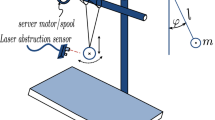Abstract
In this paper, the formulation of a block-backstepping control approach is presented to address the trajectory tracking problem for a general class of nonlinear n degrees of freedom (n-DOF) underactuated mechanical systems (UMSs) in nontriangular normal form. First, the Euler-Lagrange model of the general form of UMSs is transformed into block-strict feedback form. Then, control input for the n-DOF UMS will be obtainable by synthesis of the backstepping approach. Additionally, an integral action is incorporated to the proposed controller to enhance the steady state performance of the overall system and also to improve the trajectory tracking precision of the control system. Lyapunov theory is utilizable to prove the stability and convergence of the overall system. To demonstrate the effectiveness of the designed controller, the proposed control algorithm is applied through numerical simulation for the trajectory tracking of a single-link flexible-link flexible-joint manipulator (SFLFJM) as an UMS with the nontriangular normal form.
Similar content being viewed by others
References
Spong, M.W.: Underactuated mechanical systems. In: Control Problems in Robotics and Automation, pp. 135–150. Springer, Berlin (1998)
Liu, Y., Yu, H.: A survey of underactuated mechanical systems. IET Control Theor. Appl. 7(7), 921–935 (2013)
Olfati-Saber, R.: Nonlinear Control of Underactuated Mechanical Systems with Application to Robotics and Aerospace Vehicles. Massachusetts Institute of Technology (2001)
Fantoni, I., Lozano, R.: Non-linear Control for Underactuated Mechanical Systems. Springer Science & Business Media, London (2002)
Aneke, N.P.I.: Control of Underactuated Mechanical Systems. Technische Universiteit Eindhoven (2003)
Maalouf, D., Moog, C.H., Aoustin, Y., Li, S.: Classification of two-degree-of-freedom underactuated mechanical systems. IET Control Theor. Appl. 9(10), 1501–1510 (2015)
Zhang, M., Ma, X., Rong, X., Tian, X., Li, Y.: Error tracking control for underactuated overhead cranes against arbitrary initial payload swing angles. Mech. Syst. Signal Process. 84, 268–285 (2017)
Sepulchre, R., Jankovic, M., Kokotovic, P.V.: Constructive Nonlinear Control. Springer Science & Business Media (2012)
Kokotović, P., Arcak, M.: Constructive nonlinear control: a historical perspective. Automatica 37(5), 637–662 (2001)
Khalil, H.K.: Noninear Systems, vol. 2, pp. 5–1. Prentice-Hall, New Jersey (1996)
Krstic, M., Kanellakopoulos, I., Kokotovic, P.V.: Nonlinear and Adaptive Control Design, vol. 222. Wiley, New York (1995)
Chang, Y., Cheng, C.-C.: Block backstepping control of multi-input nonlinear systems with mismatched perturbations for asymptotic stability. Int. J. Control 83(10), 2028–2039 (2010)
Rudra, S., Barai, R.K., Maitra, M.: Nonlinear state feedback controller design for underactuated mechanical system: a modified block backstepping approach. ISA Trans. 53(2), 317–326 (2014)
Rudra, S., Barai, R.K., Maitra, M.: Block Backstepping Design of Nonlinear State Feedback Control Law for Underactuated Mechanical Systems. Springer, Berlin (2016)
Chang, Y.: Block backstepping control of MIMO systems. IEEE Trans. Autom. Control 56(5), 1191–1197 (2011)
Rudra, S., Barai, R.K., Maitra, M.: Design and implementation of a block-backstepping based tracking control for nonholonomic wheeled mobile robot. Int. J. Robust Nonlinear Control 26(14), 3018–3035 (2016)
Dong, Z., Wan, L., Li, Y., Liu, T., Zhang, G.: Trajectory tracking control of underactuated USV based on modified backstepping approach. Int. J. Naval Archit. Ocean Eng. 7(5), 817–832 (2015)
Vakil, M., Fotouhi, R., Nikiforuk, P.: A new method for dynamic modeling of flexible-link flexible-joint manipulators. J. Vib. Acoust. 134(1), 014503 (2012)
Staufer, P., Gattringer, H., Bremer, H.: Comparative study on control concepts of a robot manipulator with multiple-link/joint flexibilities. PAMM 12(1), 79–80 (2012)
Suklabaidya, S., Lochan, K., Roy, B.: Modeling and sliding mode control of flexible link flexible joint robot manipulator. In: Proceedings of the 2015 Conference on Advances in Robotics, p. 59. ACM (2015)
Author information
Authors and Affiliations
Corresponding author
Additional information
Publisher’s Note
Springer Nature remains neutral with regard to jurisdictional claims in published maps and institutional affiliations.
Appendix: Dynamic Model of the SFLFJM
Appendix: Dynamic Model of the SFLFJM
Mass matrix:
where
where
Stiffness matrix:
where
where
Dissipation matrix:
where
Gravity vector:
where
where
where
where
Rights and permissions
About this article
Cite this article
Moghanni-Bavil-Olyaei, MR., Ghanbari, A. & Keighobadi, J. Trajectory Tracking Control of a Class of Underactuated Mechanical Systems with Nontriangular Normal Form Based on Block Backstepping Approach. J Intell Robot Syst 96, 209–221 (2019). https://doi.org/10.1007/s10846-019-00984-5
Received:
Accepted:
Published:
Issue Date:
DOI: https://doi.org/10.1007/s10846-019-00984-5




